Running has long had bad PR. Hating running has been far from contentious, liking it reserved for the smug, self-congratulatory type. The consensus has seemed clear. Running is something marred by tedium, pain, and memories of the Beep Test. Looking at it like this, it is easy to see why running has been so unpopular.
And yet, miraculously, my Instagram is suddenly full of praise for it. Public opinion seems transformed. A quick search on Instagram shows that ‘#running’ racks up 93.2 million posts. It takes me less than a minute on Reels before I scroll past someone vlogging their long run, their get ready with me, their outfit of the day.
Maybe I am in an echo chamber of my own making. I tell the algorithm I like to run and it rewards me with its steady churn of content. But, the fact that new ‘run clubs’ are springing up, and more people are taking on the mantle of ‘runfluencer’ suggests otherwise.
More importantly, this apparent surge in popularity seems to have encouraged people to try running for themselves, on their own terms. Outside of being forced to run the school cross country, it seems that running can be likeable, enjoyable even. Seeing more people running changed my own opinion of it. Like many, I started running during the first lockdown. I’m not sure I can remember exactly why I started, but the popularity of ‘Run 5 Donate 5 Nominate 5’ posts certainly made the prospect less daunting. Instagram often has a way of making you try something new by making that something less intimidating, or alien.
Social media seems to be the medium, then, for running’s popularity. But what does this mean for its message?
Tempting as it is to accept the latest trend as running’s long awaited reimagining, we need to ask how it is being presented. In short videos, is the simple answer. Peppered with all the hallmarks you would expect to see on Instagram. A running rucksack and a slicked back pony (extra points for a giant scrunchie) complement a nice outfit – preferably coupled with a pastel top and colourful trainers. All of which is best viewed through the inevitable 0.5x lens shot. It is curated, it is trendy. And it is no secret that to be big on Instagram, you need to be able to sell. Personal brand, salient message, and product alike must trade on their currency. Running, in this format, is the perfect saleable commodity. It links lifestyle to product. It sells a fully integrated package.
I don’t think that this is the whole message, or what ‘running influencers’ explicitly set out to do. But formats like Reels trade on short clips, shorter attention spans, and the desire to Just. Keep. Scrolling. What is lost in such an endless medium is the detail. What is remembered is the gilt of the veneer.
This gloss perfectly combines consumerism and fabled self-discipline. Buying these trainers, this look, that is what will realise your potential. It is attractive, alluring and seemingly simple. It sits snugly with the idea that, if you just muster enough willpower to condition yourself properly, you too can feel, can be, purified. Or, in less effusive terms, you too could vlog your run to work in the City.
If that wasn’t enough, this is bedded in with a healthy dose of corporate opportunism. Run clubs are sponsored or hosted (and posted) by your favourite brands. You can try, then buy, those trainers. Be a part of the lifestyle, be a part of the brand. That is the fully integrated package.
Perhaps it stretches a one minute video too far for me to pick it apart like this, how much can really be read into its subtext after all. But I think its seemingly innocuous nature makes it more important to recognise and critique. Running has never been apolitical, exempt from the social contexts it exists in. It is easier to see where this newfound popularity has come from when you consider the message this trend promotes. It leaves unquestioned the idea that we can all be perfectly self-governing individuals, untainted and uncompromised. Even in leisure, our self-discipline is productive, and conducive, to the never-ending consumption needed to perform it.
None of this is what running is about, no matter its pretence. Of the many reasons to run, it doesn’t jump out — it seems entirely separate from the atmosphere of any races I’ve ever ran. Gone is the uniform and colour scheme. Instead, the start line is awash with friends and family running together; charity and club vests; favourite t-shirts and trusty trainers. Marshalls volunteer and encourage, alongside supporters who make noise for those they love and those they have never met. This brightness, spontaneity, and community of running will long be its best advertisement. Better than any one minute long vlog or shameless sponsorship. And despite all my railing against self-discipline, I endlessly appreciate the fact it makes it easier for me to get to sleep (sorry Foucault).


